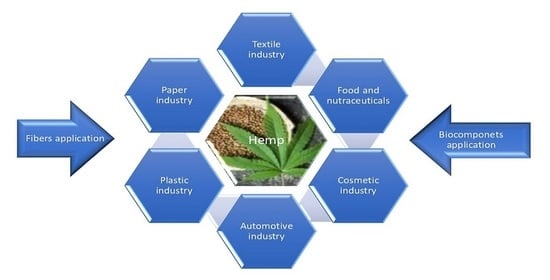Hemp: An Alternative Source for Various Industries and an Emerging Tool for Functional Food and Pharmaceutical Sectors
Abstract
1. Introduction
2. Consideration of Work
3. Hemp as a New Biocomposite
4. Hemp Grown for Hemp Extract Cannabidiol
5. Hempcrete Technology
6. Hemp Uses in Various Industries
6.1. Hemp Uses in Textiles
6.2. Hemp Uses in Papermaking
6.3. Hemp Uses in the Automotive Industry
6.4. Hemp Uses in Cosmetic Products
6.5. Hemp Uses in Plastics
7. Hemp’s Contribution to Carbon Sequestration
8. Significant Health Advantages
9. Applications of Hemp in Food and Nutraceuticals
10. Conclusions
Author Contributions
Funding
Institutional Review Board Statement
Informed Consent Statement
Data Availability Statement
Conflicts of Interest
References
- McPartland, J.M.; Guy, G.W.; Hegman, W. Cannabis is indigenous to Europe and cultivation began during the Copper or Bronze age: A probabilistic synthesis of fossil pollen studies. Veg. Hist. Archaeobot. 2018, 27, 635–648. [Google Scholar] [CrossRef]
- Fike, J. Industrial hemp: Renewed opportunities for an ancient crop. Crit. Rev. Plant Sci. 2016, 35, 406–424. [Google Scholar] [CrossRef]
- Singh, M.; Sardesai, M.M. Cannabis sativa (Cannabaceae) in ancient clay plaster of Ellora Caves, India. Curr. Sci. 2016, 110, 884–891. [Google Scholar]
- Crini, G.; Lichtfouse, E.; Chanet, G.; Morin-Crini, N. Applications of hemp in textiles, paper industry, insulation and building materials, horticulture, animal nutrition, food and beverages, nutraceuticals, cosmetics and hygiene, medicine, agro-chemistry, energy production and environment: A review. Environ. Chem. Lett. 2020, 18, 1451–1476. [Google Scholar] [CrossRef]
- Cerino, P.; Buonerba, C.; Cannazza, G.; D’Auria, J.; Ottoni, E.; Fulgione, A.; Gallo, A. A review of hemp as food and nutritional supplement. Cannabis Cannabinoid Res. 2021, 6, 19–27. [Google Scholar] [CrossRef]
- Ferreira, F.V.; Pinheiro, I.F.; de Souza, S.F.; Mei, L.H.; Lona, L.M. Polymer composites reinforced with natural fibers and nanocellulose in the automotive industry: A short review. J. Compos. Sci. 2019, 3, 51. [Google Scholar] [CrossRef]
- Ahmed, A.F.; Islam, M.Z.; Mahmud, M.S.; Sarker, M.E.; Islam, M.R. Hemp as a potential raw material toward a sustainable world: A review. Heliyon 2022, e08753. [Google Scholar] [CrossRef] [PubMed]
- Small, E.; Cronquist, A. A practical and natural taxonomy for Cannabis. Taxonomy 1976, 405–435. [Google Scholar] [CrossRef]
- Piluzza, G.; Delogu, G.; Cabras, A.; Marceddu, S.; Bullitta, S. Differentiation between fiber and drug types of hemp (Cannabis sativa L.) from a collection of wild and domesticated accessions. Genet. Resour. Crop Evol. 2013, 60, 2331–2342. [Google Scholar] [CrossRef]
- Fischedick, J.T.; Hazekamp, A.; Erkelens, T.; Choi, Y.H.; Verpoorte, R. Metabolic fingerprinting of Cannabis sativa L.; cannabinoids and terpenoids for chemotaxonomic and drug standardization purposes. Phytochemistry 2010, 71, 2058–2073. [Google Scholar] [CrossRef] [PubMed]
- Andre, C.M.; Hausman, J.F.; Guerriero, G. Cannabis sativa: The plant of the thousand and one molecules. Front. Plant Sci. 2013, 7, 19–24. [Google Scholar] [CrossRef] [PubMed]
- Leyva, D.R.; McCullough, R.S.; Pierce, G.N. Medicinal use of hempseeds (Cannabis sativa L.): Effects on platelet aggregation. In Nuts and Seeds in Health and Disease Prevention; Academic Press: Cambridge, MA, USA, 2011; pp. 637–646. [Google Scholar]
- Vonapartis, E.; Aubin, M.P.; Seguin, P.; Mustafa, A.F.; Charron, J.B. Seed composition of ten industrial hemp cultivars approved for production in Canada. J. Food Compos. Anal. 2015, 39, 8–12. [Google Scholar] [CrossRef]
- Karche, T. The application of hemp (Cannabis sativa L.) for a green economy: A review. Turk. J. Bot. 2019, 43, 710–723. [Google Scholar] [CrossRef]
- Zimniewska, M. Hemp fiber properties and processing target textile: A review. Materials 2022, 15, 1901. [Google Scholar] [CrossRef] [PubMed]
- Carus, M.; Sarmento, L. The European Hemp Industry: Cultivation, processing and applications for fibres, shivs, seeds and flowers. Eur. Ind. Hemp Assoc. 2013, 5, 1–9. [Google Scholar]
- Rehman, M.S.U.; Rashid, N.; Saif, A.; Mahmood, T.; Han, J.I. Potential of bioenergy production from industrial hemp (Cannabis sativa): Pakistan perspective. Renew. Sustain. Energy Rev. 2013, 18, 154–164. [Google Scholar] [CrossRef]
- Jabeen, N.; Majid, I.; Nayik, G.A. Bioplastics and food packaging: A review. Cogent Food Agri. 2015, 1, 1117749. [Google Scholar] [CrossRef]
- Carus, M. Market Data on Industrial Hemp—Fibres, Shivs and Seeds. 2013. Available online: http://www.fibrafp7.net/Portals/0/Michael_Carus_Day_1.pdf (accessed on 15 December 2022).
- Gedik, G.; Avinc, O. Hemp Fiber as a Sustainable Raw Material Source for Textile Industry: Can We Use Its Potential for More Eco-Friendly Production? In Sustainability in the Textile and Apparel Industries; Springer: Cham, Switzerland, 2020; pp. 87–109. [Google Scholar]
- Pari, L.; Baraniecki, P.; Kaniewski, R.; Scarfone, A. Harvesting strategies of bast fiber crops in Europe and in China. Ind. Crops Prod. 2015, 68, 90–96. [Google Scholar] [CrossRef]
- Stevulova, N.; Cigasova, J.; Estokova, A.; Terpakova, E.; Geffert, A.; Kacik, F.; Holub, M. Properties characterization of chemically modified hemp hurds. Materials 2014, 7, 8131–8150. [Google Scholar] [CrossRef]
- Madhu, P.; Sanjay, M.R.; Khan, A.; Al Otaibi, A.; Al-Zahrani, S.A.; Pradeep, S.; Gupta, M.K.; Boonyasopon, P.; Siengchin, S. Experimental investigation on the mechanical and morphological behavior of Prosopis juliflora bark fibres/E-glass/carbon fabrics reinforced hybrid polymeric composites for structural applications. Polym. Compos. 2020, 41, 4983–4993. [Google Scholar] [CrossRef]
- Piomelli, D.; Russo, E.B. The Cannabis sativa versus Cannabis indica debate: An interview with Ethan Russo, MD. Cannabis Cannabinoid Res. 2016, 1, 44–46. [Google Scholar] [CrossRef] [PubMed]
- Dingha, B.; Sandler, L.; Bhowmik, A.; Akotsen-Mensah, C.; Jackai, L.; Gibson, K.; Turco, R. Industrial hemp knowledge and interest among North Carolina organic farmers in the United States. Sustainability 2019, 11, 2691. [Google Scholar] [CrossRef]
- Abedi, E.; Sahari, M.A. Long-chain polyunsaturated fatty acid sources and evaluation of their nutritional and functional properties. Food Sci. Nutri. 2014, 2, 443–463. [Google Scholar] [CrossRef] [PubMed]
- Singh, M.; Mamania, D.; Shinde, V. The scope of hemp (Cannabis sativa L.) use in Historical conservation in India. Indian J. Tradit. Knowl. 2018, 17, 314–321. [Google Scholar]
- Zuardi, A.W. History of cannabis as a medicine: A review. Braz. J. Psychiatry 2014, 28, 153–157. [Google Scholar] [CrossRef]
- IsoHemp, S.A. IsoHemp Natural Building. Available online: https://www.isohemp.com/en (accessed on 28 June 2022).
- Hemptechglobal. Hemp Building, USA. 2019. Available online: https://hemptechglobal.com/page14/page38/page38.html (accessed on 21 December 2022).
- United States Department of Agriculture (USDA). Hemp and Farm Bill Programs. 2019. Available online: https://www.farmers.gov/manage/hemp?utm_medium=email&utm_source=govdelivery (accessed on 10 May 2022).
- Fryxell, G.E.; Kimbro, M.; Mottershead, T. The Boston trading and manufacturing co. ltd. (HK): Hemp, fashion, and the environment. Asian Case Res. J. 2001, 5, 203–225. [Google Scholar] [CrossRef]
- Edyta, M.; Piotr, P.; Marcin, D.; Kamila, B. Comparison of papermaking potential of wood and hemp cellulose pulps. Ann. Wars. Univ. Life Sci. For. Wood Technol. 2015, 91, 134–137. [Google Scholar]
- Özdamar, E.G. Hemp as a Potential Material in Architecture: Is it Possible in Turkey. J. Archit. Plan. 2021, 9, 131–154. [Google Scholar] [CrossRef]
- Tutek, K.; Masek, A. Hemp and Its Derivatives as a Universal Industrial Raw Material (with Particular Emphasis on the Polymer Industry)—A Review. Materials 2022, 15, 2565. [Google Scholar] [CrossRef]
- Peças, P.; Carvalho, H.; Salman, H.; Leite, M. Natural fibre composites and their applications: A review. J. Compos. Sci. 2018, 2, 66. [Google Scholar] [CrossRef]
- Meredith, J.; Ebsworth, R.; Coles, S.R.; Wood, B.M.; Kirwan, K. Natural fibre composite energy absorption structures. Compos. Sci. Tech. 2012, 72, 211–217. [Google Scholar] [CrossRef]
- The European Industrial Hemp Association (EIHA). Biowerkstoff-Report Report on Bio-Based Plastics and Composites. Biowerkstoff-Report Report on Bio-Based Plastics and Composites April 2010. Available online: http://nova-institut.de/pdf/bwr_april_2010.pdf (accessed on 15 December 2022).
- Oláh, A.; Tóth, B.I.; Borbíró, I.; Sugawara, K.; Szöllõsi, A.G.; Czifra, G.; Bíró, T. Cannabidiol exerts sebostatic and anti-inflammatory effects on human meibocytes. J. Clin. Investig. 2014, 124, 3713–3724. [Google Scholar] [CrossRef] [PubMed]
- Geyer, R.; Jambeck, J.R.; Law, K.L. Production, use, and fate of all plastics ever made. Sci. Adv. 2017, 3, e1700782. [Google Scholar] [CrossRef] [PubMed]
- Placido, D.F.; Lee, C.C. Potential of industrial hemp for phytoremediation of heavy metals. Plants 2022, 11, 595. [Google Scholar] [CrossRef] [PubMed]
- Adesina, I.; Bhowmik, A.; Sharma, H.; Shahbazi, A. A review on the current state of knowledge of growing conditions, agronomic soil health practices and utilities of hemp in the United States. Agriculture 2020, 10, 129. [Google Scholar] [CrossRef]
- Kraszkiewicz, A.; Kachel, M.; Parafiniuk, S.; Zając, G.; Niedziółka, I.; Sprawka, M. Assessment of the possibility of using hemp biomass (Cannabis sativa L.) for energy purposes: A case study. Appl. Sci. 2019, 9, 4437. [Google Scholar] [CrossRef]
- Kolodziej, J.; Wladyka-Przybylak, M.; Mankowski, J.; Grabowska, L. Heat of combustion of hemp and briquettes made of hemp shives. Renew. Energy Energy Effic. 2012, 163–166. [Google Scholar]
- Scarante, F.F.; Ribeiro, M.A.; Almeida-Santos, A.F.; Guimarães, F.S.; Campos, A.C. Glial cells and their contribution to the mechanisms of action of cannabidiol in neuropsychiatric disorders. Front. Pharmacol. 2021, 11, 618065. [Google Scholar] [CrossRef]
- Farinon, B.; Molinari, R.; Costantini, L.; Merendino, N. The seed of industrial hemp (Cannabis sativa L.): Nutritional quality and potential functionality for human health and nutrition. Nutrients 2020, 12, 1935. [Google Scholar] [CrossRef]
- Al-Khalifa, A.; Maddaford, T.G.; Chahine, M.N.; Austria, J.A.; Edel, A.L.; Richard, M.N.; Pierce, G.N. Effect of dietary hempseed intake on cardiac ischemia-reperfusion injury. Am. J. Physiol. Regul. Integr. Comp. Physiol. 2007, 292, R1198–R1203. [Google Scholar] [CrossRef]
- Richard, M.N.; Ganguly, R.; Steigerwald, S.N.; Al-Khalifa, A.; Pierce, G.N. Dietary hempseed reduces platelet aggregation 1. J. Thromb. Haemost. 2007, 5, 424–425. [Google Scholar] [CrossRef]
- Munson, A.E.; Harris, L.S.; Friedman, M.A.; Dewey, W.L.; Carchman, R.A. Antineoplastic activity of cannabinoids. J. Natl. Cancer Inst. 1975, 55, 597–602. [Google Scholar] [CrossRef] [PubMed]
- Hinz, B.; Ramer, R. Cannabinoids as anticancer drugs: Current status of preclinical research. Br. J. Cancer 2022, 127, 1–13. [Google Scholar] [CrossRef] [PubMed]
- Sarfaraz, S.; Afaq, F.; Adhami, V.M.; Mukhtar, H. Cannabinoid receptor as a novel target for the treatment of prostate cancer. Cancer Res. 2005, 65, 1635–1641. [Google Scholar] [CrossRef]
- Pellati, F.; Borgonetti, V.; Brighenti, V.; Biagi, M.; Benvenuti, S.; Corsi, L. Cannabis sativa L. and nonpsychoactive cannabinoids: Their chemistry and role against oxidative stress, inflammation, and cancer. BioMed. Res. Int. 2018, 2018, 1691428. [Google Scholar] [CrossRef] [PubMed]
- Perucca, E. Cannabinoids in the treatment of epilepsy: Hard evidence at last. J. Epi. Res. 2017, 7, 61–64. [Google Scholar] [CrossRef]
- Szaflarski, J.P.; Bebin, E.M.; Cutter, G.; DeWolfe, J.; Dure, L.S.; Gaston, T.E.; Ver Hoef, L.W. Cannabidiol improves frequency and severity of seizures and reduces adverse events in an open-label add-on prospective study. Epilepsy Behav. 2018, 87, 131–136. [Google Scholar] [CrossRef]
- Langford, R.M.; Mares, J.; Novotna, A.; Vachova, M.; Novakova, I.; Notcutt, W.; Ratcliffe, S. A double-blind, randomized, placebo-controlled, parallel-group study of THC/CBD oromucosal spray in combination with the existing treatment regimen, in the relief of central neuropathic pain in patients with multiple sclerosis. J. Neuro. 2013, 260, 984–997. [Google Scholar] [CrossRef]
- Simonian, J.S.; Varanasi, S.; Diaz-Fong, J.P.; Richards, G.J.; Van Nguyen, A.; Hoffman, J.A. A critical narrative review of medical cannabis in pediatrics beyond epilepsy, part II: Neurodevelopmental, movement, and pain disorders. Pediatric. Medi. 2022, 15, 15–20. [Google Scholar] [CrossRef]
- Balant, M.; Gras, A.; Ruz, M.; Valles, J.; Vitales, D.; Garnatje, T. Traditional uses of Cannabis: An analysis of the CANNUSE database. J. Ethnopharma 2021, 279, 114362. [Google Scholar] [CrossRef]
- Jeong, M.; Cho, J.; Shin, J.I.; Jeon, Y.J.; Kim, J.H.; Lee, S.J.; Lee, K. Hempseed oil induces reactive oxygen species-and C/EBP homologous protein-mediated apoptosis in MH7A human rheumatoid arthritis fibroblast-like synovial cells. J. Ethnopharma 2014, 154, 745–752. [Google Scholar] [CrossRef] [PubMed]
- Hammell, D.C.; Zhang, L.P.; Ma, F.; Abshire, S.M.; McIlwrath, S.L.; Stinchcomb, A.L.; Westlund, K.N. Transdermal cannabidiol reduces inflammation and pain-related behaviors in a rat model of arthritis. Euro. J. Pain 2016, 20, 936–948. [Google Scholar] [CrossRef]
- Gamble, L.J.; Boesch, J.M.; Frye, C.W.; Schwark, W.S.; Mann, S.; Wolfe, L.; Wakshlag, J.J. Pharmacokinetics, safety, and clinical efficacy of cannabidiol treatment in osteoarthritic dogs. Front. Vet. Sci. 2018, 5, 165–170. [Google Scholar] [CrossRef]
- Bouloc, P. Hemp: Industrial Production and Uses; CABI: Boston, MA, USA, 2013. [Google Scholar]
- Cheng, C.W.; Bian, Z.X.; Zhu, L.X.; Wu, J.C.; Sung, J.J. Efficacy of a Chinese herbal proprietary medicine (Hemp Seed Pill) for functional constipation. Am. J. Gastroenterol. 2011, 106, 120–129. [Google Scholar] [CrossRef] [PubMed]
- Lin, Z.M.; Chen, L.M.; Xia, X. The effect of different extracts from Hemp seed in mice with experimental Alzheimers disease. Pharma. Clinic. Chin. Mater. 2016, 32, 130–133. [Google Scholar]
- Booz, G.W. Cannabidiol as an emergent therapeutic strategy for lessening the impact of inflammation on oxidative stress. Free Radic. Biol. Med. 2011, 51, 1054–1061. [Google Scholar] [CrossRef]
- Lehmann, C.; Fisher, N.B.; Tugwell, B.; Szczesniak, A.; Kelly, M.; Zhou, J. Experimental cannabidiol treatment reduces early pancreatic inflammation in type 1 diabetes. Clin. Hemorheol. Microcirc. 2016, 64, 655–662. [Google Scholar] [CrossRef]
- Zhou, Y.; Wang, S.; Ji, J.; Lou, H.; Fan, P. Hemp (Cannabis sativa L.) seed phenylpropionamides composition and effects on memory dysfunction and biomarkers of neuroinflammation induced by lipopolysaccharide in mice. ACS Omega 2018, 3, 15988–15995. [Google Scholar] [CrossRef]
- Gunn, J.K.; Rosales, C.B.; Center, K.E.; Nuñez, A.; Gibson, S.J.; Christ, C.; Ehiri, J.E. Prenatal exposure to cannabis and maternal and child health outcomes: A systematic review and meta-analysis. BMJ Open 2016, 6, e009986. [Google Scholar] [CrossRef] [PubMed]
- Metz, T.D.; Stickrath, E.H. Marijuana use in pregnancy and lactation: A review of the evidence. Am. J. Obstet. Gynaecol. 2015, 213, 761–778. [Google Scholar] [CrossRef]
- Baron, E.P. Medicinal properties of cannabinoids, terpenes, and flavonoids in cannabis, and benefits in migraine, headache, and pain: An update on current evidence and cannabis science. Headache J. Headache Pain 2018, 58, 1139–1186. [Google Scholar] [CrossRef] [PubMed]
- Callaway, J.C. Hemp seed as a nutritional resource: An overview. Euphytica 2004, 140, 65–72. [Google Scholar] [CrossRef]
- Parker, T.D.; Adams, D.A.; Zhou, K.; Harris, M.; Yu, L. Fatty acid composition and oxidative stability of cold-pressed edible seed oils. J. Food Sci. 2003, 68, 1240–1243. [Google Scholar] [CrossRef]
- Montserrat-de la Paz, S.; Marín-Aguilar, F.; García-Gimenez, M.D.; Fernández-Arche, M.A. Hemp (Cannabis sativa L.) seed oil: Analytical and phytochemical characterization of the unsaponifiable fraction. J. Agri. Food Chem. 2014, 62, 1105–1110. [Google Scholar] [CrossRef]
- Metz, M.; Selg-Mann, K. Production of a Food Seasoning, e.g., Useful as a Substitute for Soy Sauce, byTwo-Stage Fermentation of Hemp Seeds. Germany Patent No. 10002389 A1, 2005. Available online: https://patents.google.com/patent/DE10002389A1/en (accessed on 21 December 2022).
- Sun, X.; Sun, Y.; Li, Y.; Wu, Q.; Wang, L. Identification and Characterization of the Seed Storage Proteins and Related Genes of Cannabis sativa L. Front. Nutri. 2021, 8, 678421. [Google Scholar] [CrossRef]
- O’Brien, K.; Blair, P. Medicinal Cannabis and CBD in Mental Healthcare; Springer: Cham, Switzerland, 2021. [Google Scholar]
- Blasi, F.; Tringaniello, C.; Verducci, G.; Cossignani, L. Bioactive minor components of Italian and Extra-European hemp seed oils. LWT 2022, 158, 113167. [Google Scholar] [CrossRef]
- Cantele, C.; Bertolino, M.; Bakro, F.; Giordano, M.; Jędryczka, M.; Cardenia, V. Antioxidant effects of hemp (Cannabis sativa L.) inflorescence extract in stripped linseed oil. Antioxidants 2020, 9, 1131. [Google Scholar] [CrossRef]
- Smeriglio, A.; Galati, E.M.; Monforte, M.T.; Lanuzza, F.; D’Angelo, V.; Circosta, C. Polyphenolic Compounds and Antioxidant Activity of Cold-Pressed Seed Oil from Finola Cultivar of Cannabis sativa L. Phyto. Res. 2016, 30, 1298–1307. [Google Scholar] [CrossRef]
- Radwan, M.M.; Elsohly, M.A.; Slade, D.; Ahmed, S.A.; Wilson, L.; El-Alfy, A.T.; Khan, I.A.; Ross, S.A. Non-cannabinoid constituents from a high potency Cannabis sativa variety. Phytochemistry 2008, 69, 2627–2633. [Google Scholar] [CrossRef]
- Flores-Sanchez, I.J.; Verpoorte, R. Secondary metabolism in cannabis. Phytochem. Rev. 2008, 7, 615–639. [Google Scholar] [CrossRef]
- Bautista, J.L.; Yu, S.; Tian, L. Flavonoids in Cannabis sativa: Biosynthesis, bioactivities, and biotechnology. ACS Omega 2021, 6, 5119–5123. [Google Scholar] [CrossRef] [PubMed]

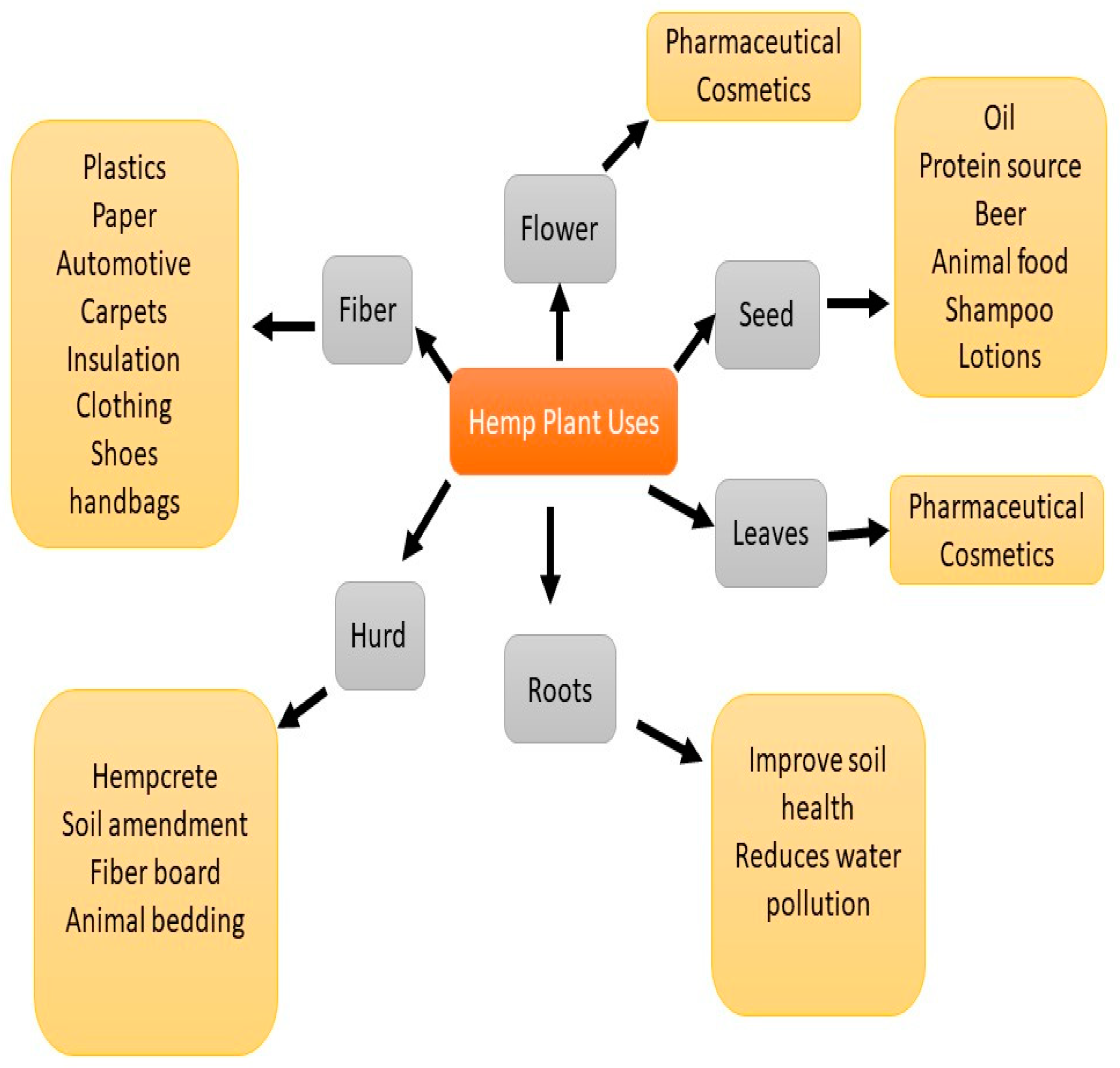
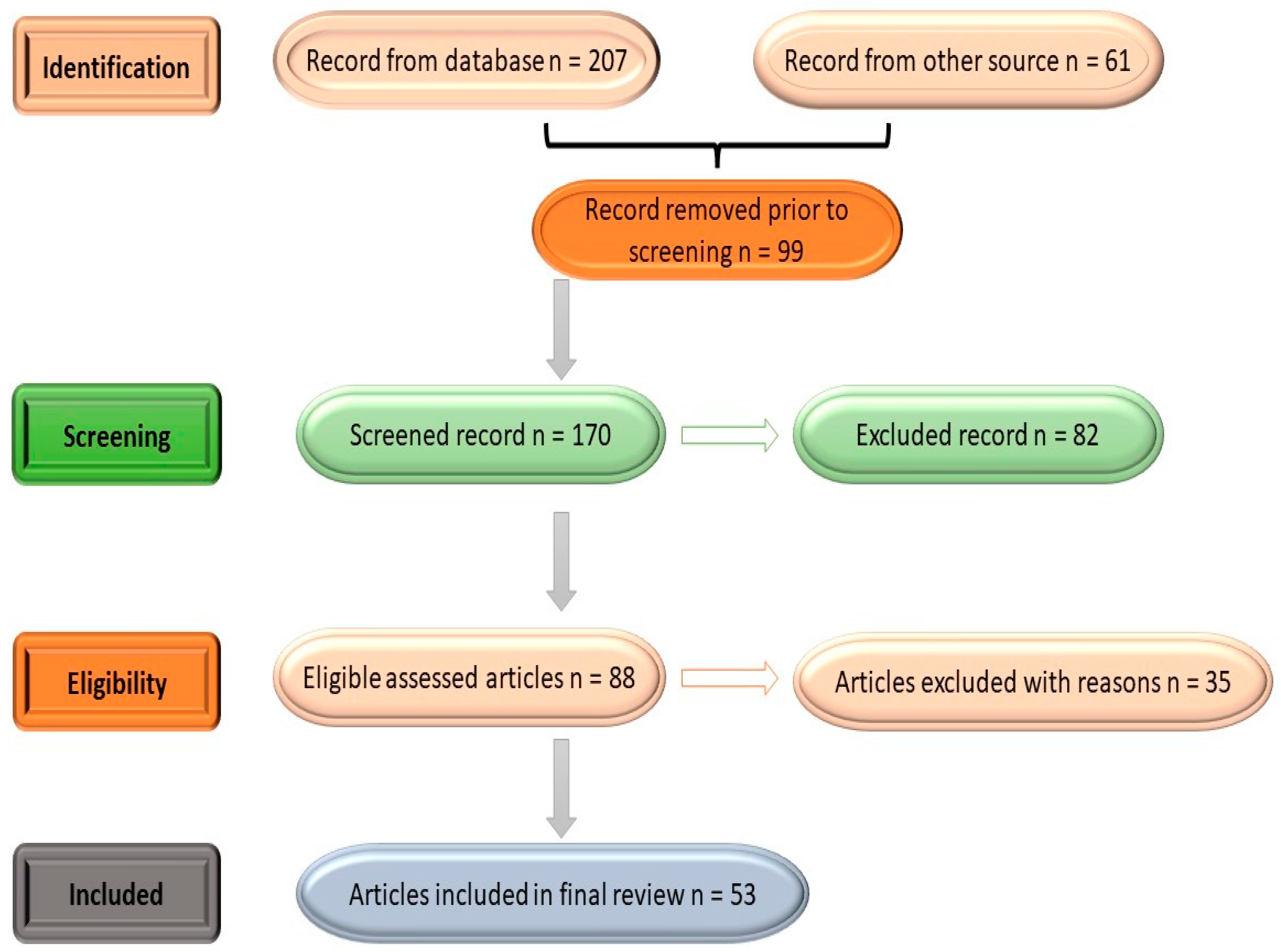
| Fiber Source | Density (g/cm3) | Length (mm) | Tensile Strength (Mpa) | Specific Tensile Strength (Mpa/g.cm−3) | Diameter (µm) | Elongation at Break (%) |
|---|---|---|---|---|---|---|
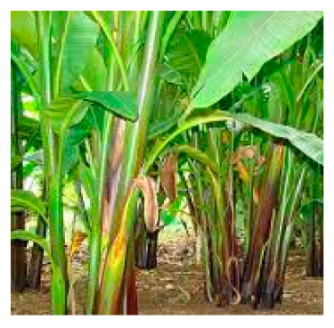 | 1.5 | - | 691 | 13.35 | - | 6.5 |
| Abaca | ||||||
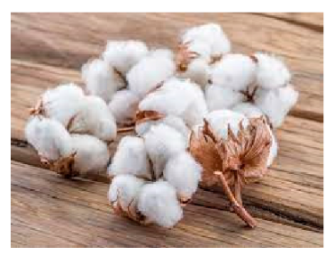 | 1.55 | 35 | 543.5 | 360 | 32.5 | 22.5 |
| Cotton | ||||||
 | 3.2 | - | 575 | 383 | 32.5 | 3.1 |
| Bamboo | ||||||
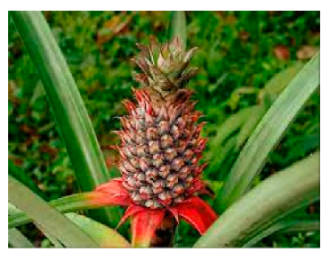 | 1.2 | 6 | 1020 | 708 | - | 3 |
| Pineapple | ||||||
 | - | 2.5 | 721 | 534 | - | 2 |
| Banana | ||||||
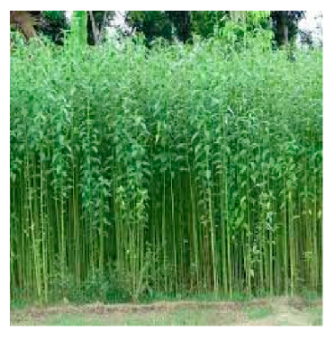 | 1.4 | 60.75 | 562.5 | 230 | 110 | 2 |
| Jute | ||||||
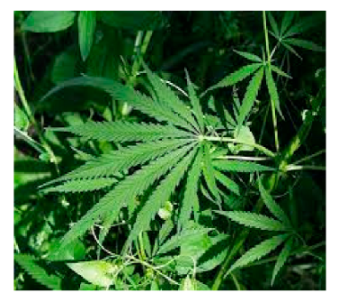 | 1.5 | 30 | 820 | 550 | 262.5 | 2.3 |
| Hemp |
| Terpene | Biodynamic Effect |
|---|---|
| β-caryophyllene | Anti-viral, antioxidant, anti-inflammatory, anticancerogenic, analgesic, anxiolytic, antibacterial, and antifungal. |
| β-myrcene | Antioxidant, anti-inflammatory, anticancerogenic, analgesic, sedative, muscle relaxant, and antipsychotic. |
| α-pinene | Anti-inflammatory, antibacterial, bronchodilator, antiseptic, and gastroprotective. |
| α-humulene | Anti-inflammatory, anticancerogenic, antifungal, and analgesic. |
| limonene | Antibacterial, antifungal, antimicrobial, antiproliferative, anxiolytic, antidepressant, antispasmodic, and gastroprotective. |
| linalool | Antineoplastic, antiepileptic, anticonvulsant, sedative, anxiolytic, antipsychotic, analgesic, antidepressant, and anesthetic. |
| S/No | Compounds | Functions | References |
|---|---|---|---|
| 1 | Apigenin | Anti-inflammatory, antioxidant, promotes or reduces the carbohydrate exposure of membrane glycolipids | [79,80] |
| 2 | Luteolin | Antioxidant, promotes or reduces the carbohydrate exposure of membrane glycolipids | [79,80] |
| 3 | Kaempferol | Antioxidant, promotes or reduces the carbohydrate exposure of membrane glycolipids | [79,80] |
| 4 | Quercetin | Antioxidant, promotes or reduces the carbohydrate exposure of membrane glycolipids | [79,80,81] |
| 5 | Orientin | Antifungal | [79,80,81] |
| 6 | Silymarin | Anti-cancer potential | [79,81] |
| 7 | Quercetin 3-O-rutinoside | Used in the treatment of heart diseases | [79,80,81] |
| 9 | Cannflavin A | Anti-inflammatory agent; anti-cancer agent | [79,80,81] |
| 10 | Cannflavin B | Anti-inflammatory agent; anti-cancer agent | [79,80,81] |
| 11 | Cannflavin C | Anti-inflammatory agent; anti-cancer agent | [80,81] |
Disclaimer/Publisher’s Note: The statements, opinions and data contained in all publications are solely those of the individual author(s) and contributor(s) and not of MDPI and/or the editor(s). MDPI and/or the editor(s) disclaim responsibility for any injury to people or property resulting from any ideas, methods, instructions or products referred to in the content. |
© 2023 by the authors. Licensee MDPI, Basel, Switzerland. This article is an open access article distributed under the terms and conditions of the Creative Commons Attribution (CC BY) license (https://creativecommons.org/licenses/by/4.0/).
Share and Cite
Naeem, M.Y.; Corbo, F.; Crupi, P.; Clodoveo, M.L. Hemp: An Alternative Source for Various Industries and an Emerging Tool for Functional Food and Pharmaceutical Sectors. Processes 2023, 11, 718. https://doi.org/10.3390/pr11030718
Naeem MY, Corbo F, Crupi P, Clodoveo ML. Hemp: An Alternative Source for Various Industries and an Emerging Tool for Functional Food and Pharmaceutical Sectors. Processes. 2023; 11(3):718. https://doi.org/10.3390/pr11030718
Chicago/Turabian StyleNaeem, Muhammad Yasir, Filomena Corbo, Pasquale Crupi, and Maria Lisa Clodoveo. 2023. "Hemp: An Alternative Source for Various Industries and an Emerging Tool for Functional Food and Pharmaceutical Sectors" Processes 11, no. 3: 718. https://doi.org/10.3390/pr11030718
APA StyleNaeem, M. Y., Corbo, F., Crupi, P., & Clodoveo, M. L. (2023). Hemp: An Alternative Source for Various Industries and an Emerging Tool for Functional Food and Pharmaceutical Sectors. Processes, 11(3), 718. https://doi.org/10.3390/pr11030718








